Apple sells two speakers–the HomePod and HomePod mini–but there are lots of different types of speakers that work with iPhone, iPad, Mac and Apple TV out there to choose from that could offer better value for money.
There’s a lot of choice with the speakers in this round up offering a wide variety of features, specs, designs and price tags. But we’re here to guide you through the complexity and help you find the best speaker for optimal performance with your Mac and iOS devices.
We look at a variety of speakers including multi-room speaker systems, which are more popular than ever–especially as mobile devices like the iPhone and iPad allow us to carry our entire music library from room to room, or connect to music streaming services such as Spotify, Apple Music or Amazon Prime Music with a quick tap.
Apple users are best off getting a speaker with AirPlay support, and all the speakers in this test offer AirPlay 2 support. We explain what AirPlay is and the features it brings later on in this article.
We’ve tested out some of the best speakers you can buy to use with your Apple products below, so read on to find out which AirPlay speakers are best.
Best speakers for iPhone, iPad, Mac and Apple TV
HomePod mini

We’re putting the HomePod mini in the top spot on the basis of its low price tag, excellent sound quality and deep integration with Apple’s software ecosystem – as long as you don’t mind being tied to Siri.
The HomePod mini can’t match the bass punch of the full-size HomePod, but the output is still far better than we have any right to expect at this size and price. (Just to reiterate, it’s a third of the price and a seventh of the weight of its larger sibling.)
For jazz, rock and classical we were blown away by its clear, rich sound. And while it’s not quite got the welly to deafen your neighbours with house music at 3am, it does fill a room beautifully – especially when teamed with a second model as a stereo pair.
Read our full
Apple HomePod mini review
Apple HomePod (2nd generation, 2023)
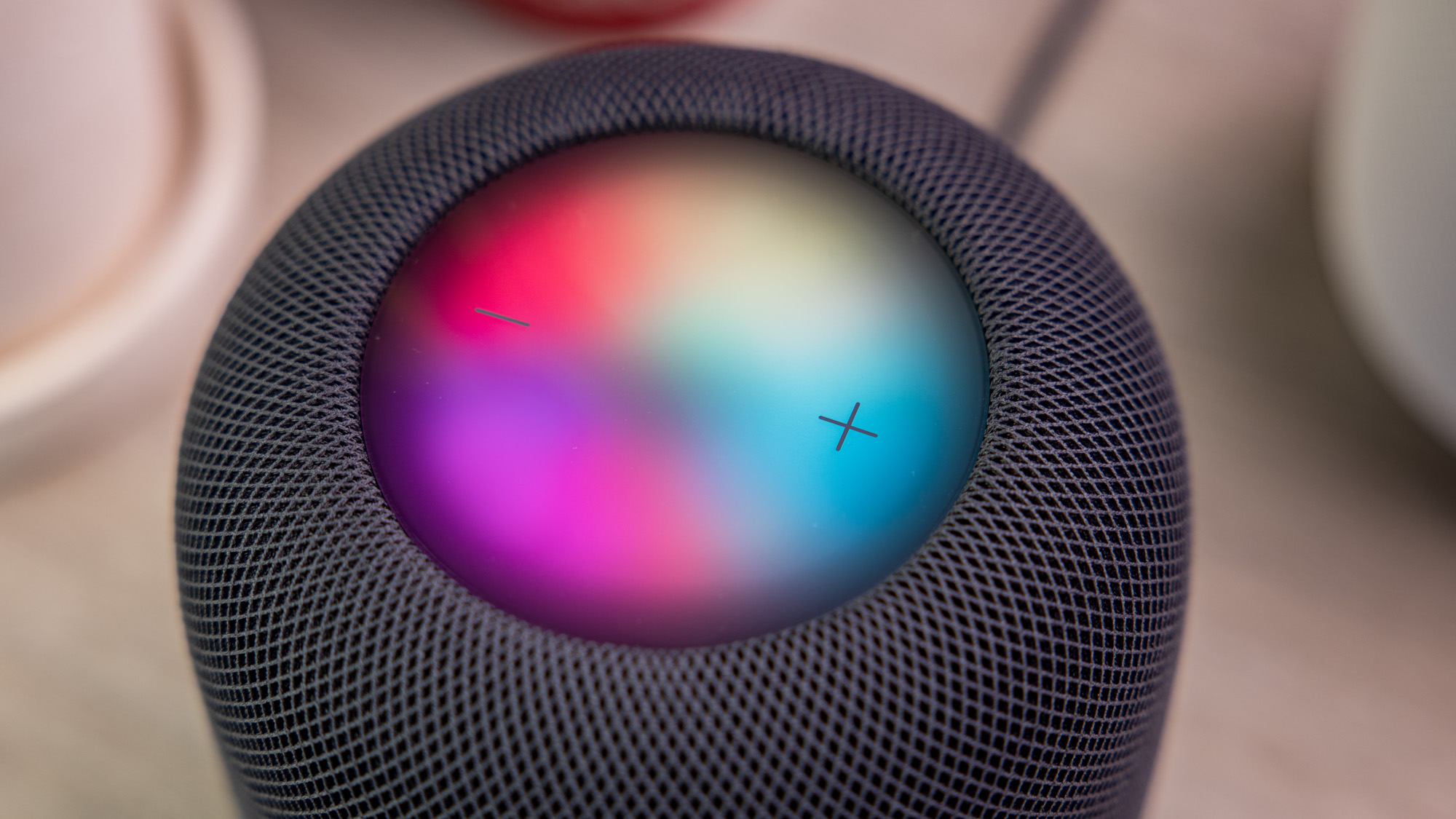
If you’re deep in the Apple ecosystem and you appreciate quality audio, this is the smart speaker for you: it will play your music beautifully and make TV watching a delight.
As with the HomePod mini, ease of setup is one of its strongest features–plug in the HomePod and wave an iPhone vaguely in its direction and an onscreen popup (on the phone) will invite you to set it up. If there’s another HomePod of the same model in the selected room, you’ll be given the option to join them as a stereo pair.
It sounds great whether used as a single unit, or as a stereo pair, and it’s a great accompaniment to your Apple TV as it supports Dolby Atmos and Spatial Audio (the HomePod mini doesn’t). To find out more, read more about how the HomePod compares to the HomePod mini.
The main disadvantages of the 2023 HomePod are the high price (three times that of the HomePod mini) and the frustrations associated with being reliant on Siri to control it.
Roku Streambar

Roku is well-known for its range of streaming media devices, which offer an affordable alternative to Apple’s own Apple TV box. However, the Roku Streambar goes a step further by combining streaming features with a compact soundbar speaker and support for Apple’s AirPlay 2 – and all for a highly competitive $129.99/£129.99.
The AirPlay support and built-in dual-band Wi-Fi mean that you can simply use the Streambar as a conventional AirPlay speaker, using AirPlay to stream music via Wi-Fi from any Apple device. It’s surprisingly powerful for such a compact speaker, and more than loud enough for playing music at home or watching a few Hollywood blockbusters. It even provides pretty good bass too, landing the bass guitar and crashing drums on Kate Bush’s The Big Sky with real impact (and Roku has recently announced a new range of wireless speakers that also support AirPlay 2, although we’ve not had the chance to test these yet).
Going beyond basic speaker mode, you can also use the HDMI port on the back of the Streambar to connect it to a TV or computer display, and this allows you to stream video at up to 4K resolution from your Apple devices as well. You can even get rid of your Apple devices altogether, and just use the Streambar’s built-in streaming features to connect your TV or computer monitor to a wide range of video services–including Apple TV+, Netflix, Disney+ and so on. It also supports a number of music streaming services too, such as Apple Music and Spotify.
Admittedly, the low cost of the Streambar means that it does lack a few advanced features, such as support for Dolby Atmos, which you can get from Apple’s HomePod and also the Apple TV 4K. But, of course, the Apple TV box doesn’t include a speaker, and the Streambar’s low-cost combination of AirPlay speaker and music and video streaming features makes it an absolute bargain at this price.
Sonos One

Sonos was the first company to really popularise multi-room speaker systems, and it was also the first to add smart voice technology to its multi-room speakers when it launched the Sonos One towards the end of 2017. The voice technology in question is Amazon’s Alexa, but Sonos did release a software update that added support for AirPlay 2: so it’s compatible with Apple’s HomePod and allows you to stream music and audio from any app on your Mac computers or iOS mobile devices.
At $199/£199 it’s a lot cheaper than the full-size HomePod and of course, the One is still compatible with other Sonos multi-room products, and can used as part of a home cinema set-up. And, rather ingeniously, if you’ve got an older Sonos speaker that doesn’t support AirPlay 2, you can use the One to control those other speakers as well.
As well as including AirPlay 2, the
Sonos app supports a wider range of streaming services than any of its rivals: 52 at the last count, including Apple Music, Spotify and Tidal, as well as specialist services such as
Nugs.net which plays live gigs, and
Qobuz for jazz and classical. And, of course, the app handles the multi-room side of things quickly and easily, allowing you to pair two of the Sonos One speakers for stereo, play different songs in different rooms, or the same song on every speaker all at once.
But a good app wouldn’t count for anything if the sound wasn’t up to scratch. As we mentioned, the One is essentially an update that adds Alexa to the original Play:1, so the two speakers provide very similar sound quality. But that’s certainly not a disappointment, as the One produces a bigger, better sound than you have any right to expect from a speaker that stands just 162mm tall.
Sonos doesn’t reveal the power of the two internal amps, but the One is perfectly capable of filling a medium-size room with sound. Its power is matched by clarity too, bringing a silky warmth to Karen Carpenter’s voice on Yesterday Once More.
The bass is a pleasant surprise too, given the speaker’s compact dimensions, and there’s a satisfyingly firm slap to the bass guitar on The Big Sky by Kate Bush. The One is also able to keep an eye on all the details as the avalanche of drums and chanting vocals mount up in the closing section of that song.
Our only minor criticism here is that the One can’t quite reach some of the really high frequencies – such as Roger Taylor’s shrieking falsetto on Queen’s Somebody To Love. We’d also like to see a wider range of connectivity features, as the Sonos One is limited to just 2.4GHz Wi-Fi and Ethernet, with no Bluetooth or even a simple 3.5mm connector.
But when it comes to sound quality, value for money and multi-room flexibility, the Sonos One yet again confirms Sonos as the leader in this increasingly competitive market.
And, if you’re on a tight budget, there’s now a second model – called the One SL – that ditches the microphone and voice controls, and just provides the speaker on its own for $199/£179.
Read our full
Sonos One review
Sonos Roam

Sonos’ Roam has to be the smallest and most portable AirPlay 2 speaker we’ve seen so far.
The Roam is a real mini-marvel, measuring just 6.61 x 2.36 x 2.44-inches (168 x 60 x 62mm), you can stand it upright or lay it flat on the ground or on a desk or table. It only weighs 0.95lb (0.43kg), so it’s easy to carry around in a backpack when you’re travelling – in fact, it’s so small that you could probably even slip it into a jacket pocket without too much trouble if you needed to.
It’s well suited for outdoor use too, with a rechargeable battery that lasts for up to 10 hours, depending on how loud you like your music. The Roam is also really sturdy, with an IP67 rating for water and dust resistance – and, according to Sonos, that means you can actually submerge it in 1m of water for up to 30 minutes, so it’ll cope with being rained on with no trouble at all.
Even the battery charging is clever – you can charge it with the USB-C cable included with the box, but the base of the Roam works with Qi wireless chargers, so you can just sit it on the same charging pad that you use for your iPhone, or buy one of Sonos’s own wireless chargers for $49/£44.
When you’re outdoors you can just use it as a conventional Bluetooth speaker, although the Roam isn’t at its best in Bluetooth mode as it doesn’t support either Apple’s AAC codec for Bluetooth, or AptX for Android. But, when you get back home, you can just switch the Roam into Wi-Fi mode and use it as an AirPlay 2 speaker on your home network.
And the sound that it produces with AirPlay streaming is pretty remarkable for such a compact little speaker. The soaring orchestral sound of The Waves, by Max Richter, is really impressive – clear and detailed, and with just enough power to really wash over you like, well, waves of sound. But switch to something a bit noisier, and there’s a crisp crunch to the jangling guitar riff on Blondie’s One Way Or Another that will really get the mood going at a BBQ or an outdoor music event. The bass could be a little firmer, but that’s asking a lot from such a tiny little speaker, and at this price the sturdy design and clear, detailed sound of the Roam make it an absolute bargain.
Read our full
Sonos Roam review
Audio Pro A15
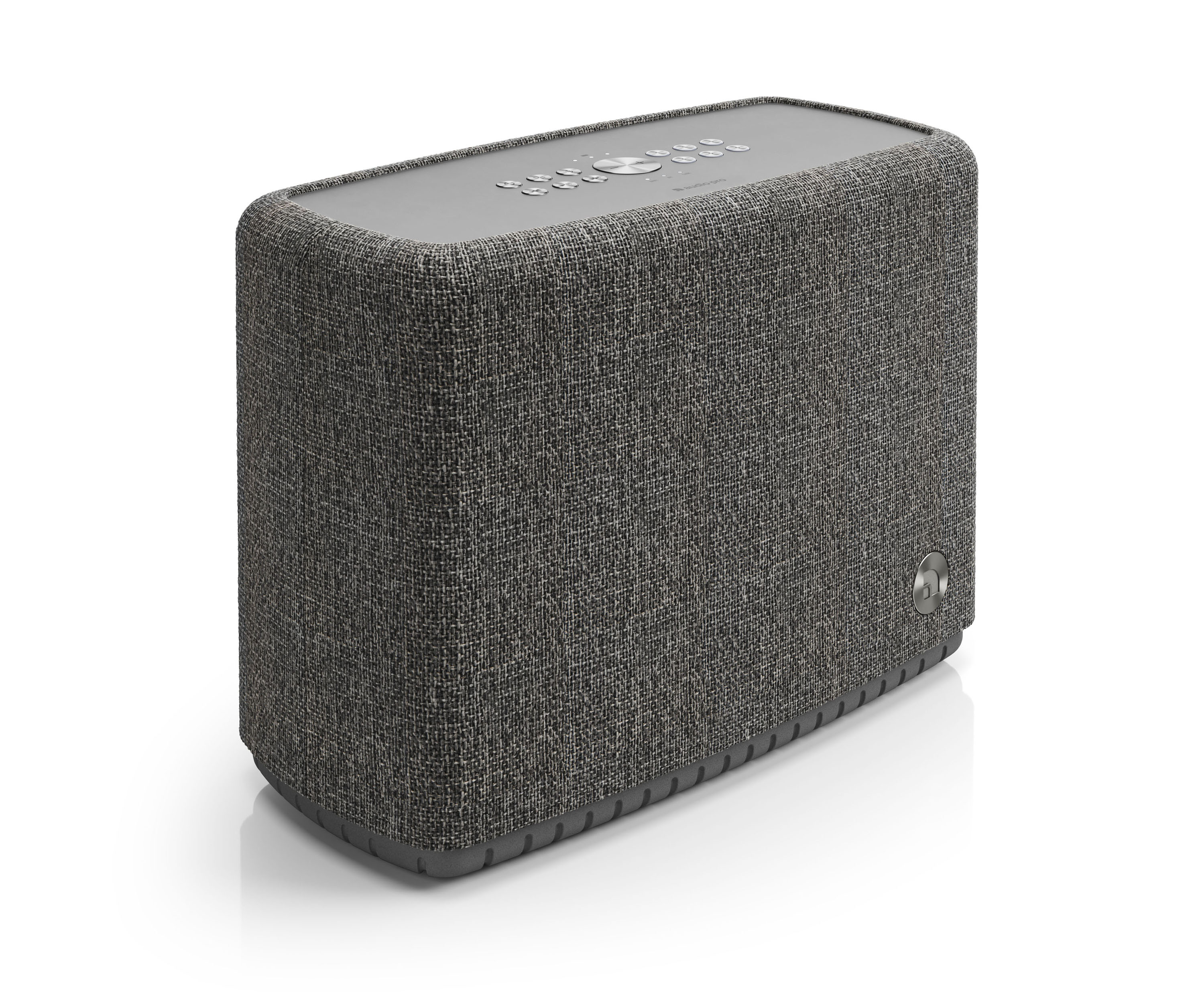
The Sonos Roam is a terrific little portable speaker, complete with AirPlay support, but its extremely compact design means that it’s not the most powerful speaker around. If you want something with a bit more power that can also venture outdoors occasionally, then the A15 from Audio Pro is a really good option. It’s slightly more expensive than Apple’s HomePod, but its portable design and connectivity features make it a lot more versatile than the HomePod (there’s also a smaller model, called the A10 which costs just $250/£149 but isn’t portable as it lacks an internal battery).
The A15 is quite large, measuring 8.1 x 11.2 x 5.3-inches (206 x 286 x 137mm), and weighing in at a fairly hefty 2.2lb (3.4kg). However, it’s still light enough to carry from room to room, or out into the garden when the summer comes along, and there’s a bass port on the back of the speaker that doubles up as a handle so that you can quickly pick it and head outdoors when you want to. The smart fabric cover is also rated IPX2 for water-resistance, to ensure that it can cope with the occasional burst of rain. Battery life is good too, lasting for eight hours at full blast, or 11 hours at 50% volume. The A15 supports dual-band Wi-Fi with AirPlay 2 for Apple devices, Google Cast for our Android friends, as well as Bluetooth and a 3.5mm connector for wired audio.
You’ll need to download the Audio Pro app to connect the A15 to your Wi-Fi network, but after that it works just like any other AirPlay speaker, allowing you to play any music or video from your Apple devices. It sounds great too, with the large speaker providing a firm, pulsing bass on Low’s Cut. There’s an icy clarity to the haunting steel guitar, but also warmth too, on singer Alan Sparhawk’s softly spoken vocals. And, if you really want to go to town at party-time, the A15 even has a connector for hooking it up to an external sub-woofer too.
Edifier S1000W

Most AirPlay speakers have a compact, all-in-one design, very similar to Apple’s HomePod. However, these compact speakers don’t provide very good stereo separation, and there are many people who may need a proper two-piece (2.0) speaker system that really shows how stereo audio is meant to sound. Edifier’s S1000W is a good stereo system for musicians who are recording their own songs, or for podcasting or video-editing that involves audio editing work. And, of course, it sounds great for just listening to your favourite music too.
The two-piece S1000W costs $449.99/£399.99 – which is a lot cheaper than buying two HomePods and using them for stereo. The two speakers are solidly built, with an attractive wood finish, which also helps to reduce vibrations that might affect the sound quality. They stand 7.8 x 13.6 x 11.6-inches (345 x 198 x 295mm), so they need a fairly large desk or shelf, but we were able to stand them on either side of our office iMac’s screen without too much trouble, so they’re well suited for audio work for musicians or other content creators.
All the controls are located on the right-hand speaker, which includes an impressive number of both wired and wireless input options. There are 3.5mm, RCA, optical and coaxial connectors for devices such as CD players or turntables, and you can quickly switch between inputs using the remote control included in the box. And, for wireless audio, the S1000W also supports Bluetooth, dual-band Wi-Fi and AirPlay 2 for streaming from Apple devices. The S1000W provides a thumping 120W total output, and I was only able to set the volume level to around 50% before I started to worry about annoying the neighbours. And it’s not just loud – the sound quality is great too, with the sturdy speakers providing a firm, rhythmic bass when playing Billie Elish’s Bad Guy, combined with clear, precise vocals and higher frequencies.
Denon Home 550
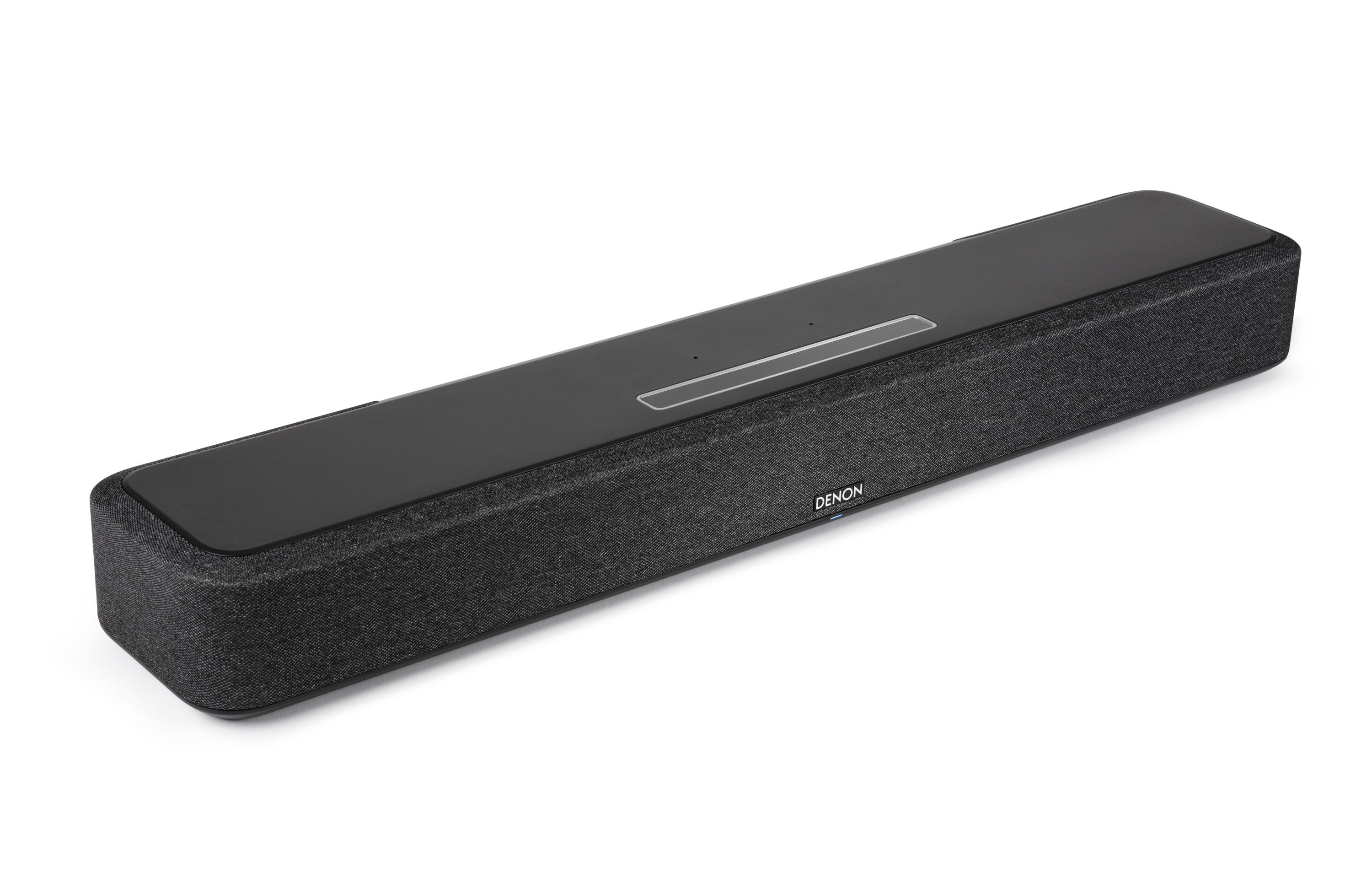
Apple is very keen on getting people to buy two of the second-gen HomePods in order to use them for stereo music, or for watching films and video that have a soundtrack that uses the Dolby Atmos surroundsound format. That’s not the only option for film buffs, though, and there are plenty of soundbars that support both AirPlay 2 and Dolby Atmos, including the Denon Home 550.
The Home 550 costs $649 in the US, which is slightly more expensive than a pair of HomePods ($598), but it’s a lot more versatile when it comes to connecting to non-Apple devices, and fitting into a larger home entertainment system. And, in the UK, the price is £599 (compared to £598 for two HomePods).
As mentioned, the Home 550 supports dual-band wi-fi with support for AirPlay 2, but also includes Ethernet for wired networks too, along with Bluetooth and a standard 3.5mm connector for non-Apple devices. It has two 4K HDMI ports for connecting to a TV, and an optical audio connector for older TVs that don’t support HDMI.
The Denon app helps you to connect the Home 550 to your network for AirPlay streaming, or you can use the remote control that’s included in the box to quickly switch between AirPlay, Bluetooth and other audio sources.
The large soundbar – 25.95 x 2.95 x 4.72-inches (650 x 120 x 75mm) – produces an equally large sound, with deep, pulsing bass on The Orb’s Prime Evil, and a nervous, manic energy on the rattling percussion. And, switching into Dolby Atmos mode, it works a treat on the opening scene of Blade Runner, with a dramatic bass rumble on the bursts of flame that leap across the Los Angeles skyline. It also creates a real sense of movement as Harrison Ford’s hover-car zooms forward out of the screen and the sound pans smoothly over to my left-hand side.
Harman Kardon Citation 300

Harman Kardon has a wide variety of speakers in its Citation range, from a cute little bedside alarm clock to large stereo speakers costing more than £2,000. The sweet spot for us, though, is the mid-range
Citation 300, which costs £349.99 in the UK – but isn’t widely available in the US, as Harman thinks that the minimalist ‘Scandi’ design of the speakers is more suited to European tastes.
The design is very attractive, with the speaker wrapped up in a special woollen fabric called Kvadrat, which is available in either black or grey. Designed in Denmark, Kvadrat is a sturdy type of wool that is designed to be dirt-repellent and flame-retardant, so it’s well suited for use in different rooms around the home.
The speaker measures 7.09 x 12.95 x 5.59-inches (180 x 306 x 142mm), and weighs 9.04lb (4.1kg), so you’ll need a bit of shelf space to set it up but, as we mentioned, there are several other models in the range – including the portable Citation 200, which we also like a lot – so you can easily find a model that’s right for your home.
The smart design includes other features too, such as a small touch-sensitive control screen, which allows you to adjust volume and other settings, and even displays album artwork for the music that you’re playing. The speaker supports dual-band Wi-Fi for connecting to your home network, but can also work with Bluetooth when required. Our only complaint is that there’s no 3.5mm audio connector for wired devices, such as my old CD player.
The Citation 300 does support AirPlay 2 for Apple devices, but the bad news is that it also works with the Google Home voice assistant, and you actually have to use the clunky – and privacy pilfering – Google Home app when you initially set up the speaker for the first time. But once that’s done the Citation shows up as an ordinary AirPlay speaker in the sound controls of your Mac or iOS devices, so you can then delete the Google app and switch to AirPlay instead. It’s worth that initial bit of hassle too, as the Citation 300 sounds great.
The clarity of the sound is immediately obvious, with Roger Taylor’s swooping falsetto cutting sharply through the air on The Kiss, from Queen’s Flash Gordon soundtrack. The orchestral strings have a lush, romantic feel to them, and the Citation 300 catches all the little details, such as the gentle, warbling flutes that punctuate the surging strings.
At the other end of the spectrum, the size and weight of the speaker means there’s real body to the sinister, threatening electronic bass on You Should See Me In A Crown by Billie Eilish. It’s not the cheapest AirPlay speaker currently available, but that versatility makes the Citation 300 a great choice for playing many different styles of music – and with 100W output, it’s powerful enough to form the centrepiece of your multi-room home music system.
Belkin SoundForm Connect
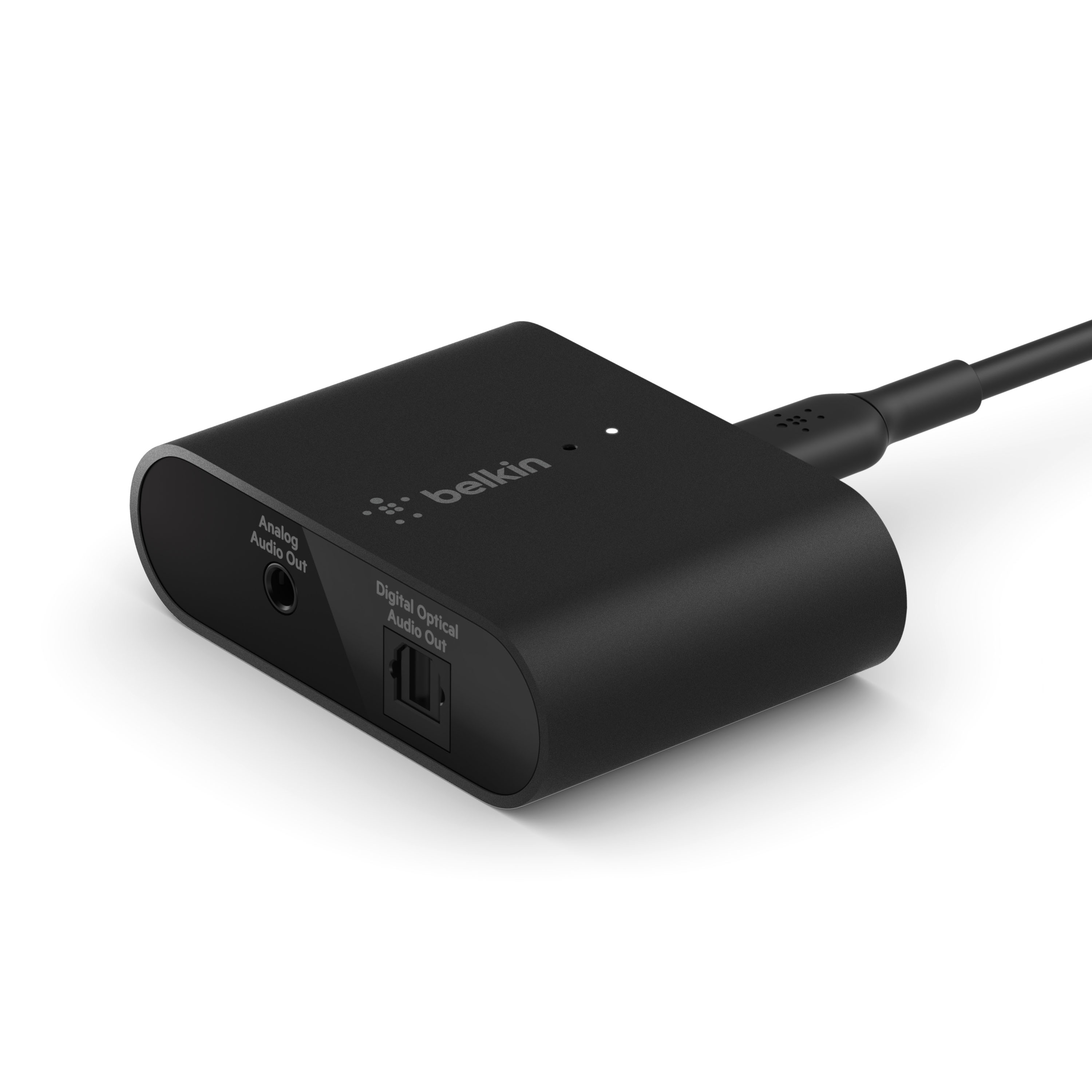
AirPlay is a terrific audio technology for Apple devices, but you don’t have to buy a brand new speaker to use AirPlay. Belkin’s SoundForm Connect is a really handy adaptor that can be used to add AirPlay 2 compatibility to any wired speakers that you already own. It only costs $99.99/£89.99 so it’s a lot cheaper than buying a new set of AirPlay speakers – especially if you have a good Hi-Fi or stereo system at home that you’d like to keep using. It could also come in handy for work, perhaps for use with an AV system in a conference room when you’re giving a presentation.
The compact little adaptor measures just 0.75 x 2.44 x 1.71-inches (19 x 62 x 44mm), so it’s easy to sit on any convenient desk or shelf when you want to connect it to your speakers. The front panel has both 3.5mm and optical audio connectors, which will allow you to connect a wide variety of speakers and Hi-Fi equipment (although you do need to provide your own audio cables).
On the back there’s a USB-C port, which provides power for the SoundForm’s wi-fi features, and you can either power the SoundForm using a USB port on a Mac or PC, or with the mains power adaptor that’s included in the box.
The SoundForm can use NFC to connect to your iPhone during set-up, but there are also instructions on Belkin’s web site for performing a manual connection with other devices. Once the SoundForm is connected to your wi-fi network it simply shows up as an AirPlay speaker within Control Centre and any other apps that you want to use on your Apple devices. You can then stream music to the SoundForm, which sends the audio to your speakers via the 3.5mm or optical audio connectors.
Bowers & Wilkins Zeppelin

Bowers & Wilkins’ Zeppelin was a landmark product for Mac users – and it’s great to see it back again.
Originally launched in 2007, the Zeppelin was the first Hi-Fi-quality speaker system for the iPod, and really helped to boost that device’s credibility amongst audiophile music fans. A few years later an updated Zeppelin was also one of the first speakers to support Apple’s AirPlay software for streaming audio over Wi-Fi. However, the Zeppelin was left behind when Apple released AirPlay 2 – with its new support for multi-room music – so it was discontinued a few years ago. But now, with very little fanfare, B&W has launched a new version of the Zeppelin that adds support for AirPlay 2, along with a number of other new features too.
Available in either ‘midnight grey’ or a silvery ‘pearl grey’, the new Zeppelin initially looks very similar to its predecessors, with the eye-catching oval design that gives the speaker its name. But on the inside, the Zeppelin has been completely redesigned, with a pair of high-frequency tweeters and mid-range woofers located on each side of a central sub-woofer, while the entire unit is powered by a roof-rattling 240W amplifier.
As mentioned, the new Zeppelin now supports AirPlay 2, along with Bluetooth and Apple’s AAC codec and the AptX Adaptive codec that is used on many Android devices, and Spotify Connect too. My only minor complaints are that the Zeppelin only seems to work with 2.4GHz Wi-Fi, and it’s completely reliant on Wi-Fi or Bluetooth for streaming, with no wired inputs for connecting to devices such as a CD player, or maybe even an old iPod.
The sound quality, though, is terrific, with the massed harmonies of Queen’s Somebody To Love ringing out bright and clear, and a lively, ringing tone on Roger Taylor’s shrieking falsetto and crashing cymbals. At the other end of the spectrum, the Zeppelin delivers the bouncing bass on Bad Guy by Billie Eilish with a firm, taut sound that immediately gets you tapping your foot. It easily fills the room with sound even at just 40% of maximum volume, so the Zeppelin will be great for getting the party going over Christmas and the New Year.
It is a little pricey, at $799/£699, but that’s only slightly more expensive than Apple’s AirPods Max, and the Zeppelin is certainly better value for money. What’s more, its room-filling sound and AirPlay 2 support mean you can share its excellent sound quality with everyone in your home.
How to choose an AirPlay speaker
There’s a lot to think about when buying an AirPlay speaker so make sure you read this buying advice before splashing the cash.
Music streaming & compatibility
Having your favourite music follow you around your home is great, but conventional multi-room speakers often have significant limitations. Many, for example, will only work with a limited number of streaming services that are built into the apps provided by each manufacturer.
As you might expect, most will work with Spotify, while
Tidal and
Deezer also get a lot of support. But for some reason, Sonos is one of the few manufacturers of multi-room speakers that also supports Apple Music. In fact, some speakers only provide apps for iOS or Android mobile devices, which means that you can’t even play music from iTunes on a Mac.
The other big problem with conventional speakers in the past was that you have generally had to buy them all from one manufacturer when assembling a multi-room setup because rival speakers were incompatible and wouldn’t work together.
AirPlay vs AirPlay 2
The speaker market changed dramatically in 2018 with the release of Apple’s updated AirPlay 2 software. Released to coincide with the original HomePod launch, AirPlay 2 has also been licensed to a number of well-known manufacturers, which means there’s now a wide range of compatible speakers available. In fact, every model in our top 10 works with AirPlay 2.
The first version of AirPlay, released back in 2010, was like a souped-up version of Bluetooth, allowing you to stream audio from any app on your Mac or iOS devices to any AirPlay-compatible speaker and freeing you from reliance on the manufacturer’s apps. AirPlay also uses a Wi-Fi connection, which means a higher bandwidth than Bluetooth and better sound quality – not to mention longer range.
The simplicity and versatility of AirPlay is great, but – like Bluetooth – its original version was only designed to work with one speaker at a time. AirPlay 2 takes Apple into the multi-room market, with the ability to stream music to several speakers in different rooms. (Alternatively, you can
create a HomePods stereo pair in the same room.)
But the real game-changer with AirPlay 2 was ‘interoperability’, the ability to link together speakers from different manufacturers for the very first time. This means you can mix and match speakers around your home – picking, for instance, a HomePod as your main living-room speaker, a Sonos One in the bedroom, and Libratone’s portable Zipp 2 for drinks in the garden – and have them all linked up to play music simultaneously.
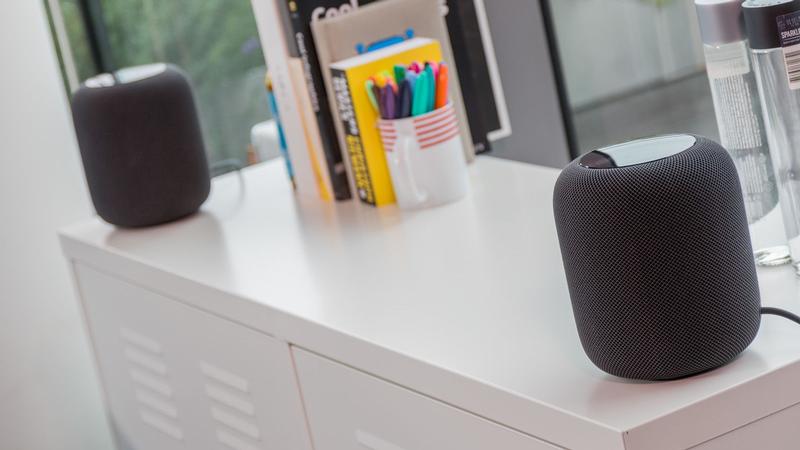
Which version of AirPlay is supported?
The important thing to remember is that there are now two types of AirPlay speaker. Some older models will use the original version of AirPlay – which is limited to streaming music to one speaker at a time – but new speakers (and certainly all the speakers in this article) focus on AirPlay 2. Some will have the AirPlay logo on the packaging, but this doesn’t specify whether it’s AirPlay or AirPlay 2. It’s therefore important to check which version is supported by any speaker before buying.
Given that AirPlay 2 has been around for three years, it would be surprising to see a manufacturer release an AirPlay 1 speaker right now, but it doesn’t hurt to check. You don’t want to get caught out.
It’s also worth mentioning that some older AirPlay speakers can be upgraded to work with AirPlay 2 as well. Libratone’s new Zipp 2 uses AirPlay 2, but it’s possible to download a software update for the older first-generation Zipp speakers that adds support for AirPlay 2. Unfortunately, that’s not the case with all AirPlay speakers, and some models are stuck with basic AirPlay.
Sound Quality vs Price
The fact that Apple licenses both AirPlay and AirPlay 2 to other manufacturers has other advantages too. Namely, the option to choose from a wide range of (often lower-cost) third-party speakers from companies like Sonos and Ikea.
At the other extreme, some really expensive hi-fi systems in the pipeline offer AirPlay 2 support for audiophiles and home cinema buffs. These options give you flexibility: you can spend heavily on a really high-quality speaker for your living room, for example, while opting for a less expensive model in the kitchen.
Indoors and Outdoors
Some manufacturers provide more specialised speakers too, such as soundbars that you can use with your TV, or sub-woofers that can provide a bass boost for parties, or for sound effects when watching films.
Some even include rechargeable batteries and lightweight, portable designs so you can pick them up and carry them from room to room – which is certainly cheaper than buying a new speaker for each room – or take them out into the garden for a barbecue.
Connectivity
Connectivity is another key issue. The HomePod has been criticised for relying on Wi-Fi for streaming, with no option for quick and easy Bluetooth streaming for Android and other non-Apple devices. It doesn’t have a 3.5mm audio connector either, which would allow you to use it with a CD player or other audio devices.
Fortunately, many AirPlay and AirPlay 2 speakers provide a greater range of connectivity, allowing you to play music from a wider range of devices than the HomePod. Sonos has even announced it will be releasing an AirPlay 2 amplifier soon that can form the centrepiece of a serious home entertainment system.
In other words, AirPlay 2 is here to stay.



